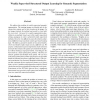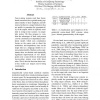1826 search results - page 7 / 366 » Using Random Forests in the Structured Language Model |
ICALP
2007
Springer
14 years 2 months ago
2007
Springer
Following the idea developed by I. Simon in his theorem of Ramseyan factorisation forests, we develop a result of ‘deterministic factorisations’. This extra determinism propert...
CVPR
2012
IEEE
11 years 11 months ago
2012
IEEE
We address the problem of weakly supervised semantic segmentation. The training images are labeled only by the classes they contain, not by their location in the image. On test im...
ACL
2010
13 years 6 months ago
2010
Tree-to-string systems (and their forestbased extensions) have gained steady popularity thanks to their simplicity and efficiency, but there is a major limitation: they are unable...
IPM
2007
13 years 8 months ago
2007
We describe a compression model for semistructured documents, called Structural Contexts Model (SCM), which takes advantage of the context information usually implicit in the stru...
CVPR
2011
IEEE
13 years 4 months ago
2011
IEEE
In this paper we present a framework for the recognition of collective human activities. A collective activity is defined or reinforced by the existence of coherent behavior of i...


